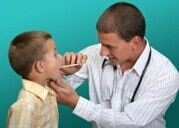 Tonsillitis refers to active inflammation of tonsils--the active gland that is responsible for secreting antibodies to maintain wellness. Normal tonsils are responsible for protecting the body against the infection, causing pathogens that are capable of invading the biological system via mouth. Upon infection, the tonsils become red and enlarged, often times the surface of tonsils is covered with a white or yellow coating of cellular debris or pus. Infection of tonsil can be contagious that may spread from infected person to contacts via oral secretions and mucus.
Tonsillitis refers to active inflammation of tonsils--the active gland that is responsible for secreting antibodies to maintain wellness. Normal tonsils are responsible for protecting the body against the infection, causing pathogens that are capable of invading the biological system via mouth. Upon infection, the tonsils become red and enlarged, often times the surface of tonsils is covered with a white or yellow coating of cellular debris or pus. Infection of tonsil can be contagious that may spread from infected person to contacts via oral secretions and mucus.
Tonsillitis Symptoms
Tonsillitis usually targets children of pre-school age and early teenage years. Listed below are the associated tonsillitis symptoms and signs:
- Headache
- Stiff neck
- In younger children stomach-ache is usually the first symptom to appear
- Bad breath
- A muffled or scratchy throaty voice
- Tender enlarged glands in the neck
- Fever
- Pain or difficulty in swallowing
- Sore throat
- Swollen, red tonsils with a coating of yellow or white debris
Younger children are a fairly common victim of tonsillitis; however, it is usually hard for them to express their feelings in words. Most common tonsillitis symptoms in very young patients are:
- Unusual fussiness, irritability and crying spells
- Refusal to eat
- Drooling because of painful or difficulty swallowing.
Causes and Risk Factors of Tonsillitis
Causes of Tonsillitis
The first defence line against illness is tonsils. These glands are responsible for producing white blood cells to assist the body in fighting off infections and communicable diseases. Tonsils fight against viruses and bacteria that invade the body via mouth; however, sometimes during the process of warding off these infections, these glands may get infected or inflamed by microorganisms leading to tonsillitis.
Most common causative agents include viruses, such as a cold, or a bacterial infection, such as strep throat. Children are at high risk of exposure to these agents due to direct transmission of pathogens via physical contact with other infected children.
Risk Factors of Tonsillitis
Listed below are the risk factors that make you tend to get tonsillitis symptoms.
- Young age: Most frequent victims of tonsillitis are younger, immune-deficient children.
- Exposure to germs: Due to close contact with other children, school kids are more vulnerable to thebacteria and viruses causing tonsillitis. Risk of developing an active infection also increases if the pathogens get on the objects that come close in contact to eyes, nose, mouth or other mucous membranes or when these agents get on the skin.
- Close contact with infected person: Living in close contact with a person with active tonsillitis can increase the risk of transmission. With sneezing, coughing and breathing, the pathogens are transmitted to the normal healthy subjects via droplet infectionliving in close vicinity.
- Nasal obstruction: Obstruction of nasal pathway results in mouth breathing which escalates the chances of tonsillitis.
Home Remedies for Tonsillitis
Mild tonsillitis doesn’t necessarily need any pharmacological treatment, especially if it’s caused by a viral agent like RSV (respiratory syncytial virus). Listed below are some home remedies to relieve tonsillitis symptoms like sore throat:
- Use OTC (over the counter) painkillers like acetaminophen or ibuprofen. Aspirin is not suitable for children due to high risk of Reye’s syndrome, so make sure to consult a doctor before giving aspirin to your child.
- Moisten the airwitha humidifier to minimize the respiratory discomfort.
- Utilize throat lozenges with caution. Although lozenges offer almost immediate soothing relief, it has been observed that these agents pose choking hazard in young children.
- Gargle with warm saline to sooth the discomfort.
- Optimize rest and avoid excessive exertion and stress. Avoid talking unnecessarily and in loud voice.
- Drink lots of fluids. Make sure you don’t let your throat dry as it may lead to coughing and more pain.
- Avoid exposure to smoking. For proper and speedy recovery, minimize tobacco use. The tar and chemicals in cigarette irritates the delicate biological tissues and impairs the recovery speed. So it is of great help to quit smoking and keep away from second hand smoke in order to prevent the worsening of tonsillitis symptoms. Since tonsillitis mostly targets the children, be sure to know that smoking and second-hand smoking have potentials of great harm.
Learn more about home remedies to ease tonsillitis symptoms by watching this video:
When to See a Doctor
If you are experiencing the following symptoms, it is highly recommended to see a doctor.
- Sore throat coupled with any of the 2 markers of bacterial infection listed below:
- Unilateral throat pain
- Increasing difficulty upon swallowing food or water (that is interfering with oral intake)
- Headache and pain in the abdominal area
- Rash
- Tender swollen tonsils
- Tonsils coated with pus or discharge
- Having fever of 101°F (38.3°C) or more
- Swollen lymph nodes in the neck
- Dehydration signs like dry tongue and mouth along withsubstantial decrease in urinary frequency.
- Breathing problems. Persistent and continued breathing through mouth, snoring and a voice that’s much muffled or nasal in character.
- Despite continued treatment, if you are experiencing more than 7 episodes of tonsillitisin one year; your doctor may advise surgical removal to improve the quality of life.
- Sore throat or tonsillitis which begins after exposure to people who have strep throat.
- Severe pain that is increasing in intensity and refractory to home remedies.
- Excessive drooling in case of young children.